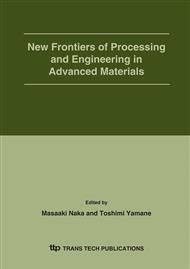p.339
p.345
p.351
p.361
p.367
p.373
p.379
p.385
p.393
Fabrication of Lotus-Type Porous Metals, Intermetallic Compounds and Semiconductors
Abstract:
Lotus-type porous materials, whose long cylindrical pores were aligned along the same direction, were fabricated by unidirectional solidification in a pressurized gas atmosphere. The pores were formed in the solidified materials as a result of precipitation due to supersaturated gas during solidification of the liquid material dissolved with gas atoms. The lotus-type porous materials with homogeneous size and porosity of the evolved pores can be obtained by the mould casting method with constant solidification rate for the materials with high thermal conductivity. On the other hand, the novel continuous floating zone melting method was invented to fabricate the porous materials with low thermal conductivity. Recently we succeeded in fabricating lotus-type porous materials such as various metals and alloys, intermetallic compound Ni3Al and NiTi, and semiconductor silicon. The fabrication conditions comprise a pressure up to 3.0 MPa and the use of a mixture gas of hydrogen (or nitrogen ) and argon (or helium). Such lotus-type porous materials are expected to be employed in various applications such as machine parts, biomedical materials, etc.
Info:
Periodical:
Pages:
367-372
Citation:
Online since:
December 2005
Authors:
Price:
Сopyright:
© 2005 Trans Tech Publications Ltd. All Rights Reserved
Share:
Citation:


